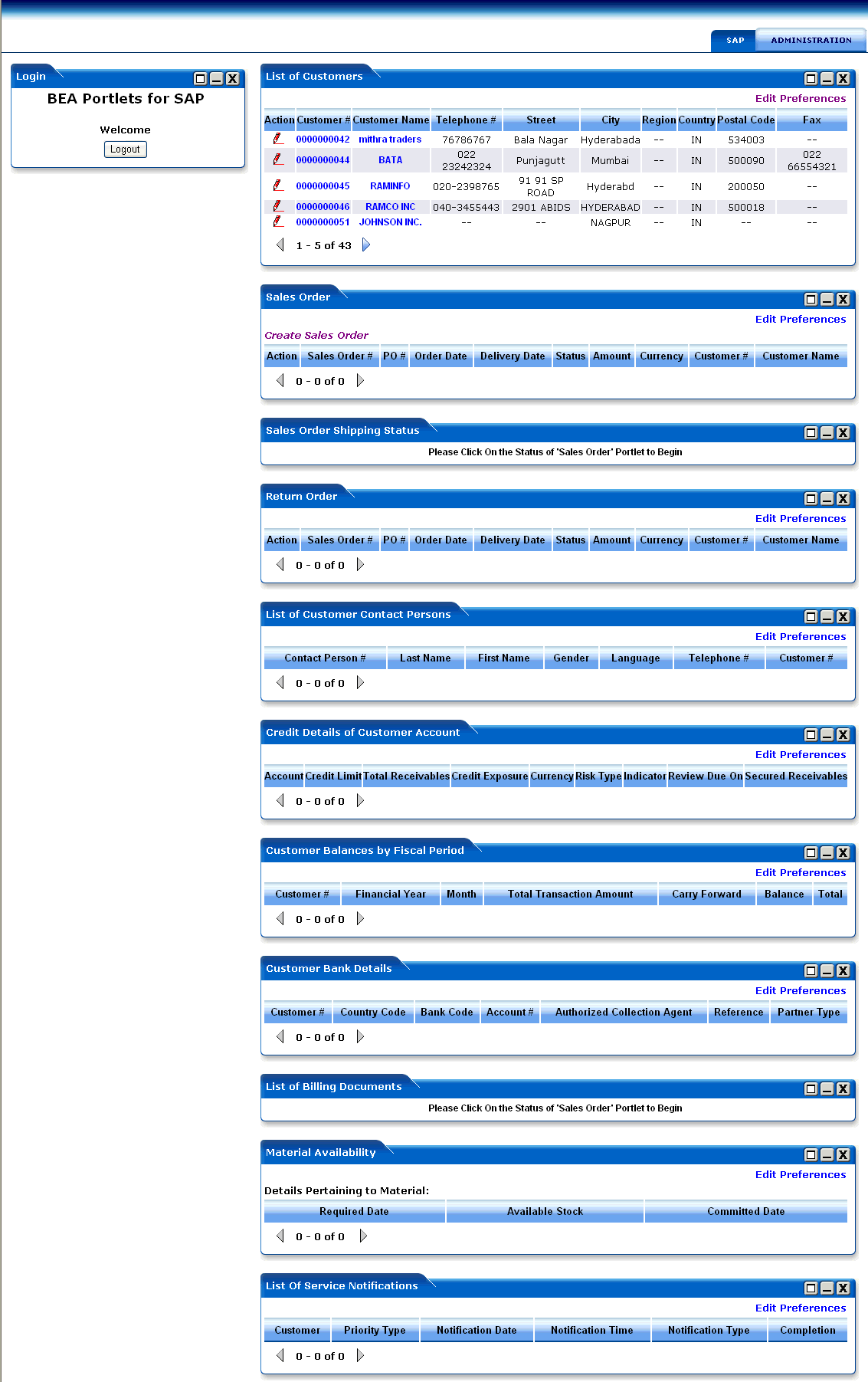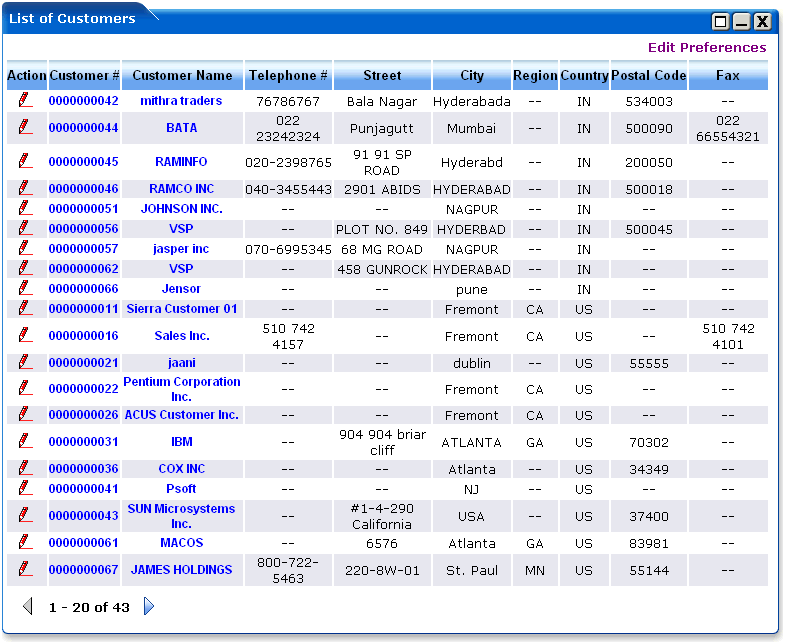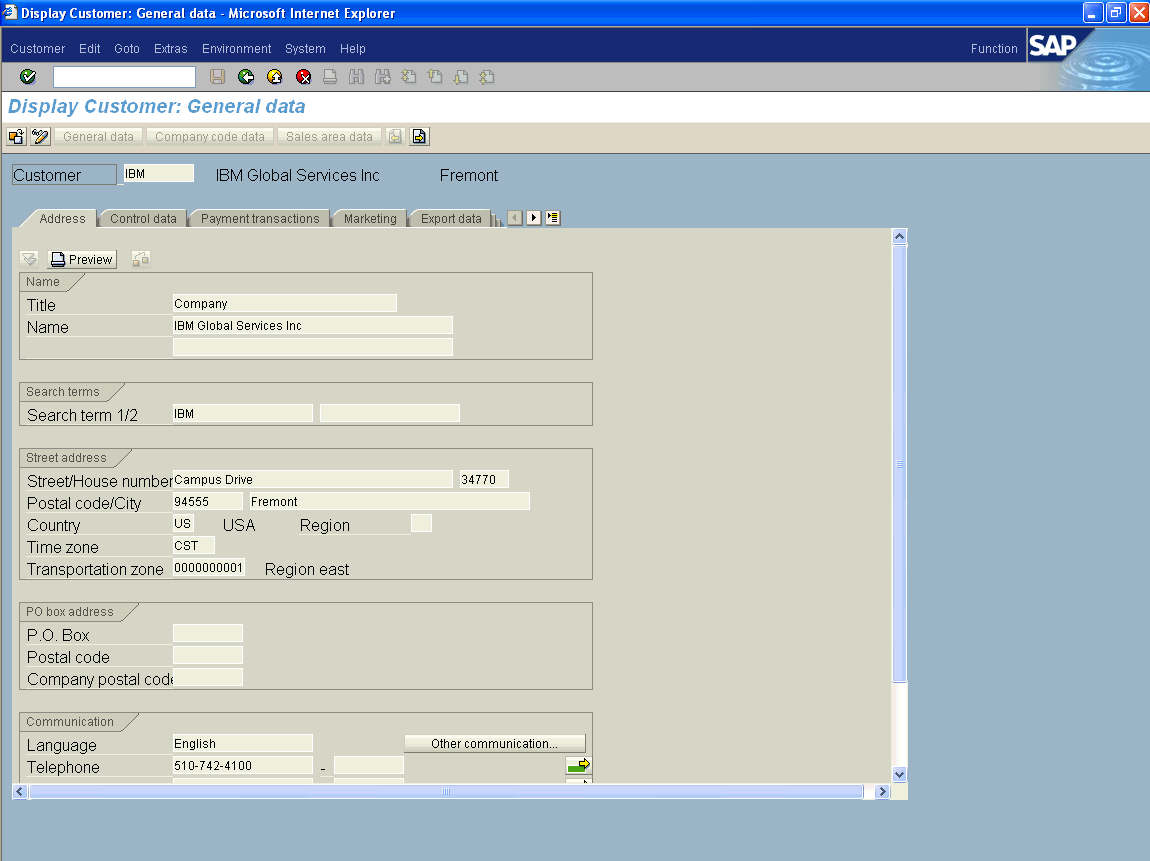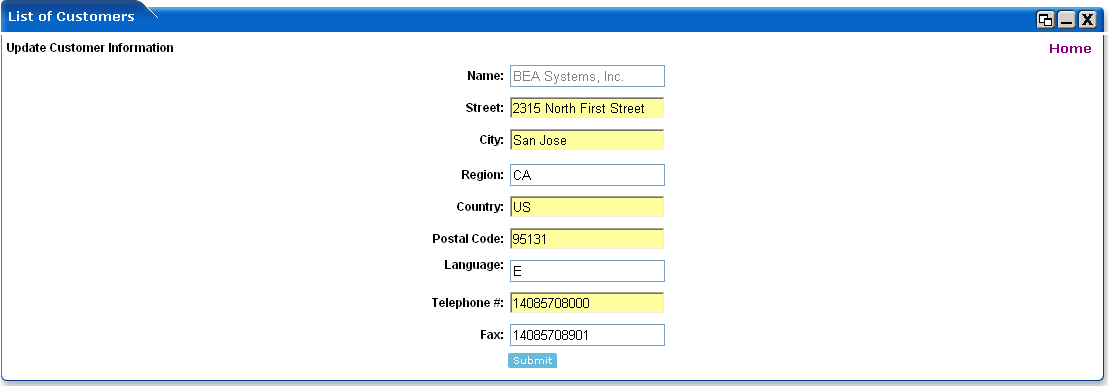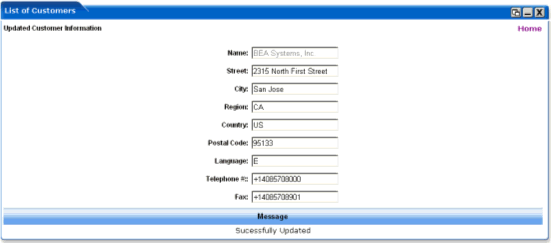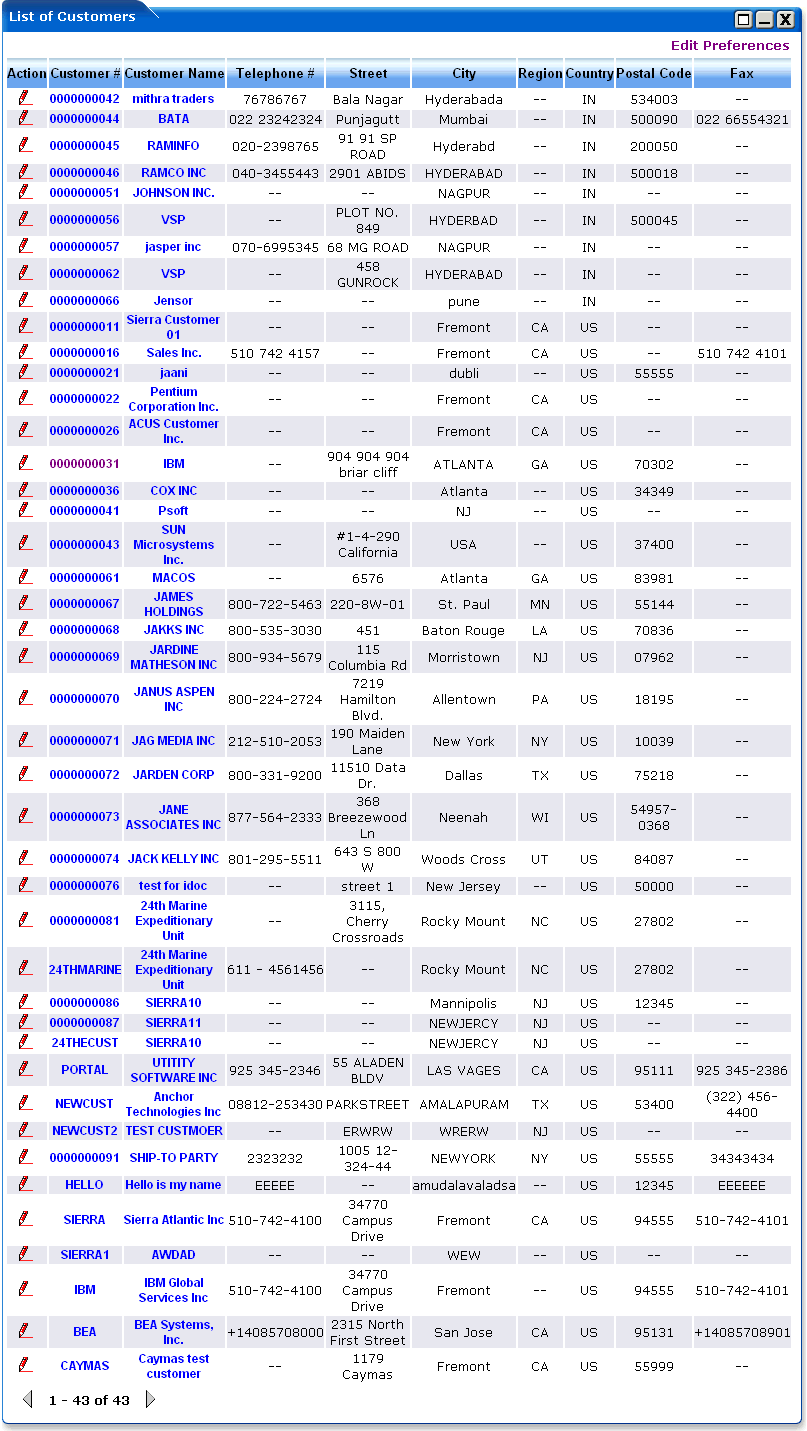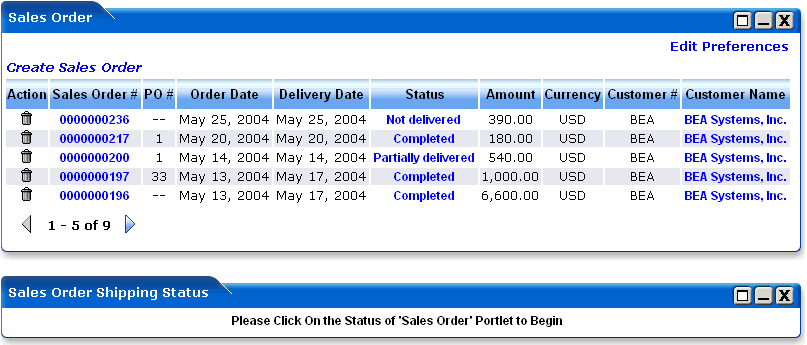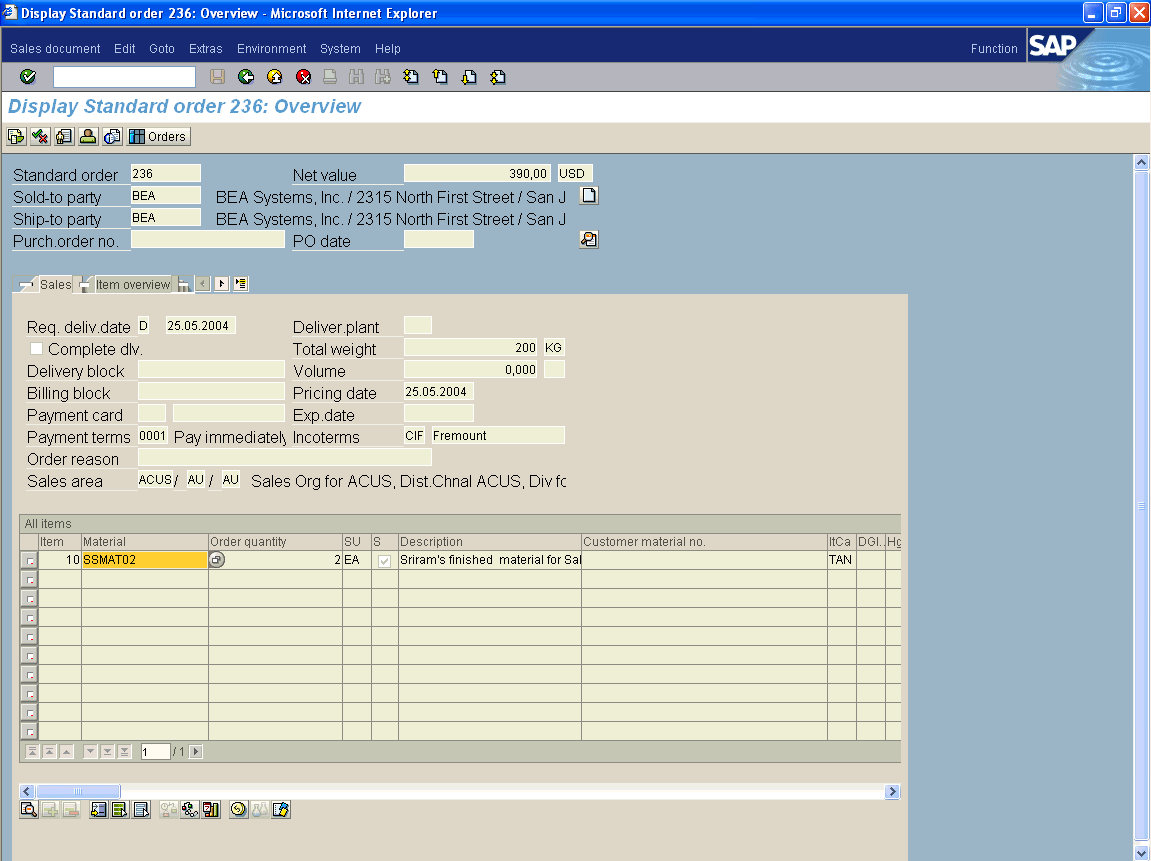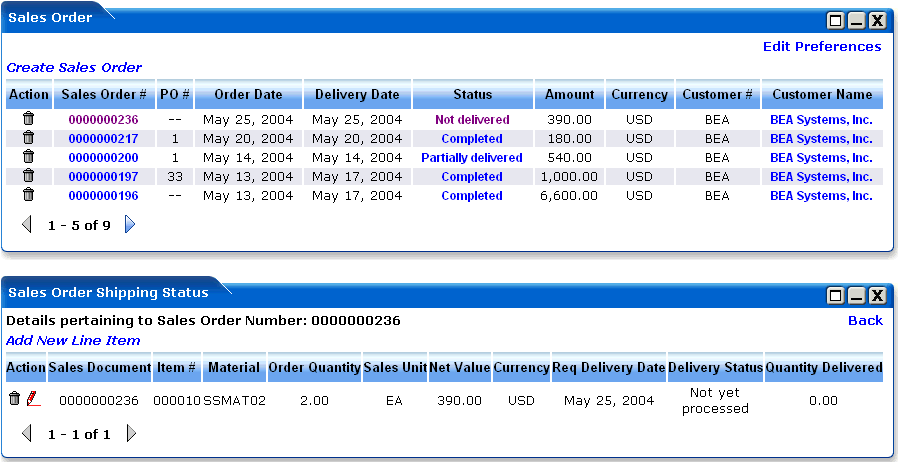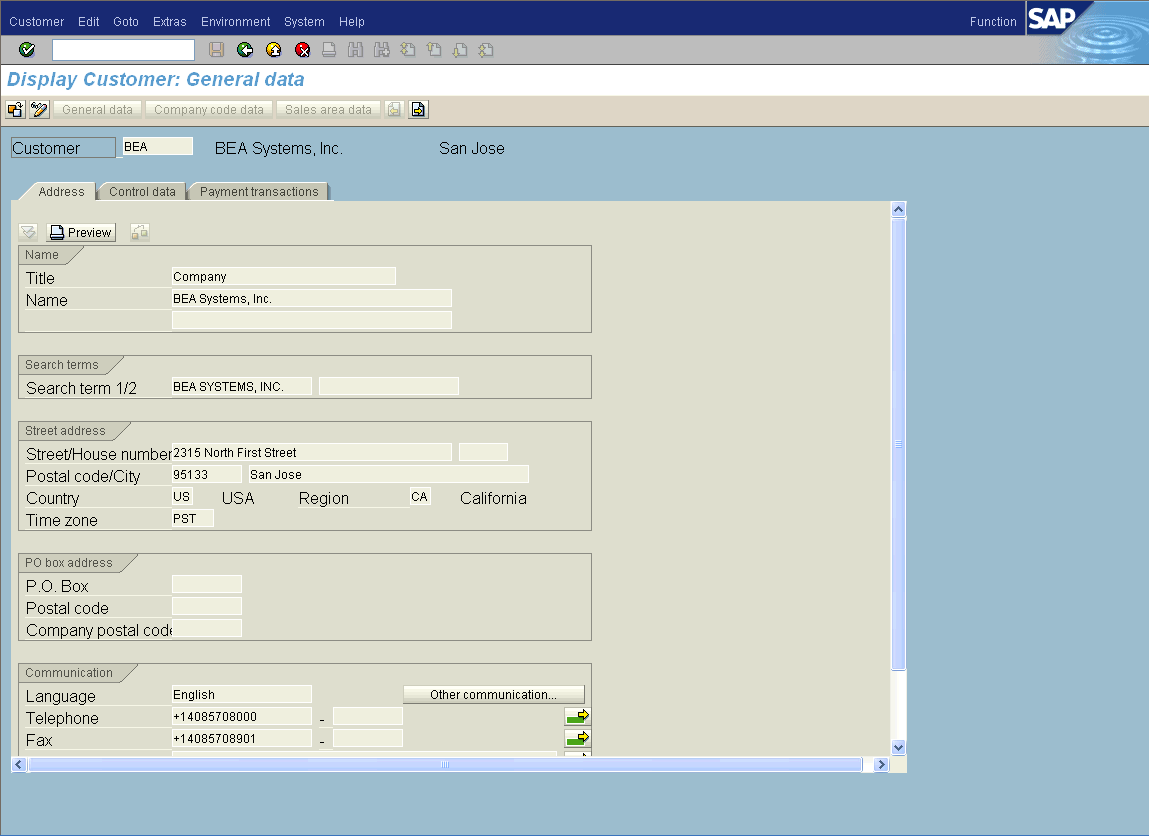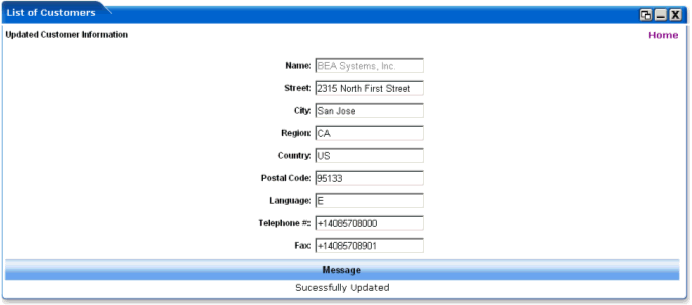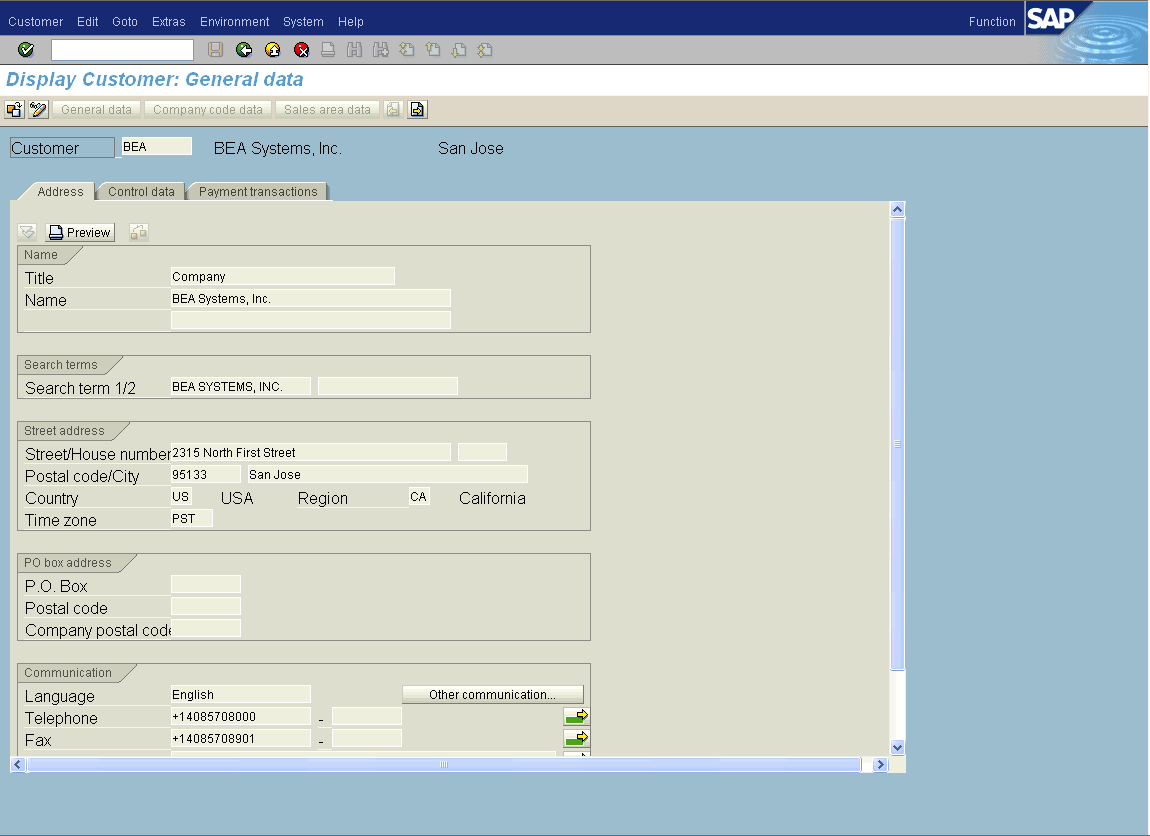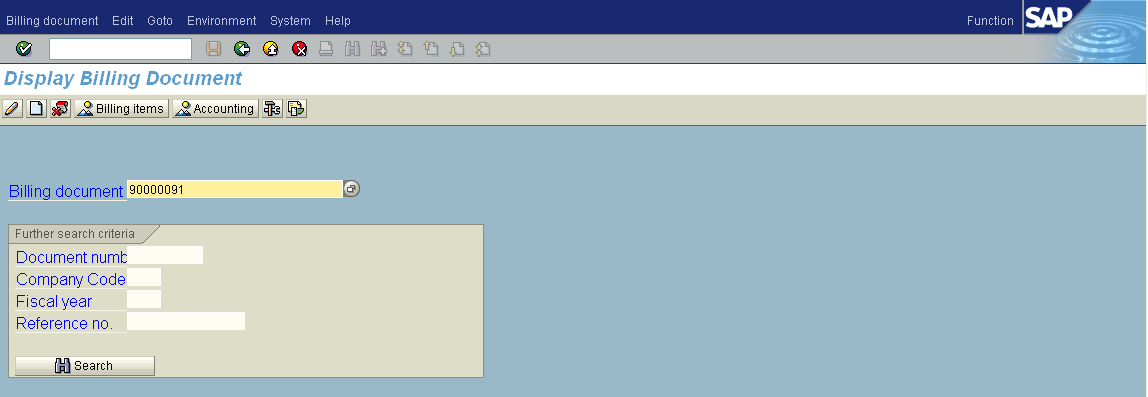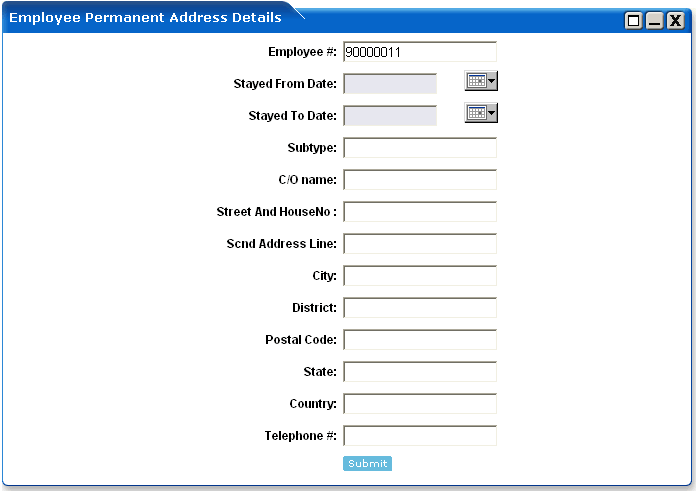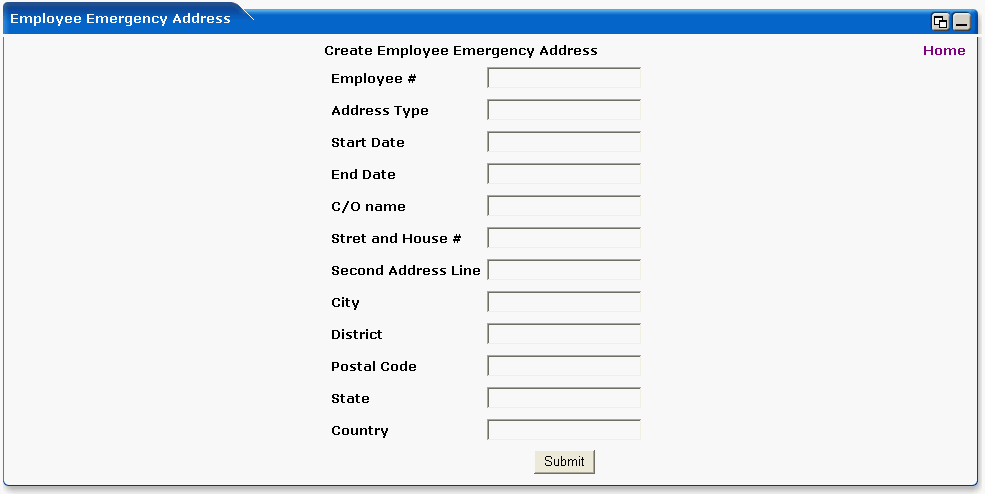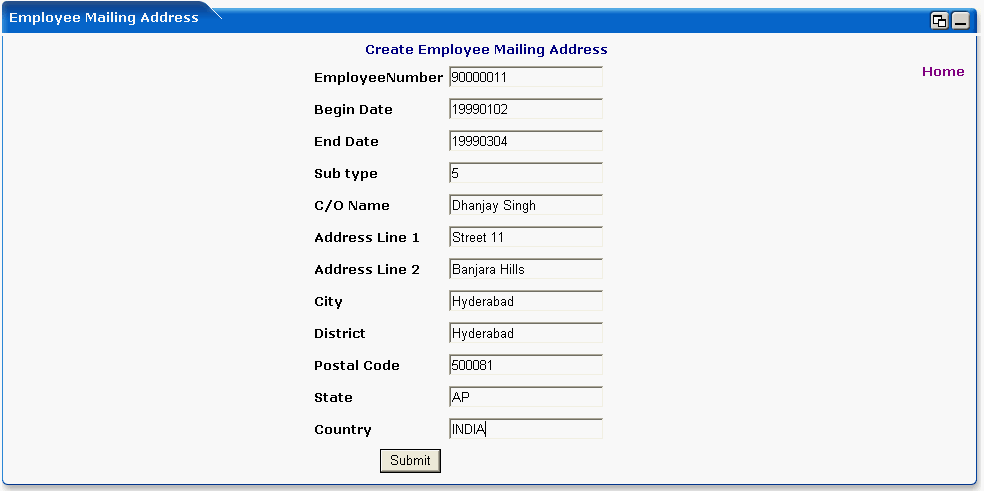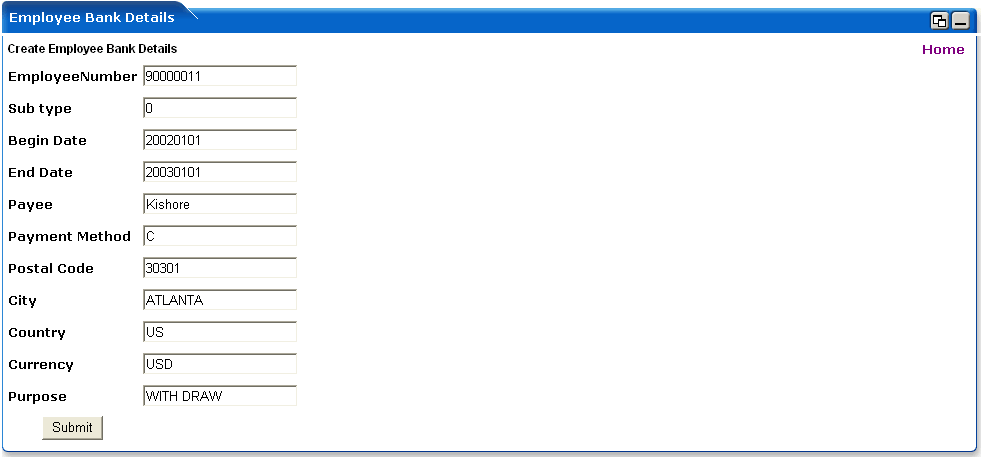WebLogic Portlets for SAP and SAP HRMS User Guide
|
|
|
WebLogic Portlets for SAP and SAP HRMS User Guide
This guide, which shows you how to use the WebLogic Portlets for SAP, includes the following sections:
- WebLogic Portlets for SAP Introduction
- Getting Started with WebLogic Portlets for SAP
- List of Customers Portlet
- Sales Order Portlet
- Return Order Portlet
- List of Customer Contact Persons Portlet
- Credit Details of Customer Account Portlet
- Customer Balances by Fiscal Period Portlet
- Customer Bank Details Portlet
- List of Billing Documents Portlet
- Material Availability Portlet
- List Of Service Notifications Portlet
- WebLogic Portlets for SAP HRMS Introduction
- Getting Started with WebLogic Portlets for SAP HRMS
- Login Portlet
- Personal Data Portlet
- Employee Permanent Address Portlet
- Employee Emergency Address Portlet
- Employee Mailing Address Portlet
- Employee Family Member-Dependents Portlet
- Employee Bank Details Portlet
- Employee Health Benefits Portlet
- Employee Insurance Benefits Portlet
- Employee Expenses Portlet
- Employee Pay Checks
WebLogic Portlets for SAP Introduction
Since the dawn of World Wide Web users have been accessing one Web page at a time. And that's been just fine. At first, excitement over the ability to provide platform-agnostic content to all users with network access or an Internet connection overshadowed any drawbacks or inadequacies with the new technology. Later, emerging technologies such as Java, JavaScript, and application servers provided application functionality, usability, stability, and performance improvements that have been the mainstay of Internet computing.
Now organizations need more. They want to not only surface their legacy applications, processes, and data in a Web interface, but they want to be able to do so more than one page at a time. They want portals.
A portal is a powerful Web site that gives users a single point of access to applications and information in a unified interface. A portal lets users view each application or Web page in its own window, called a portlet, and a single browser window can contain multiple portlets. For example, a portal page can contain portlets for logging in, searching, displaying news feeds, and managing appointments with a calendar application, as shown in the following Figure.
Figure 1 Portal desktop Screen
Portlets are arranged or grouped on portal pages, and users can easily navigate among pages with page tabs, drop-down menus, or other mechanisms to access the portlets they want. The portal in Figure 1 contains three pages: Home, My Workspace, and HR, whose links appear just above the Login portlet.
SAP R/3- WebLogic Portlets for SAP automates change and product content propagation related business processes that span across SAP R/3 and WebLogic Portlets for SAP.
Business Goals of WebLogic Portlets for SAP
Business Requirements addressed by WebLogic Portlets for SAP at a high level are:
- Integrating SAP R/3 with WebLogic Portlets for SAP.
- Facilitating real time collaborative practices between organization partners by transferring information from SAP R/3 to WebLogic Portlets for SAP.
- Ensuring a smooth and fast Product Content propagation in high volume transactions scenario.
Key Features of WebLogic Portlets for SAP
Key design goals of WebLogic Portlets for SAP are:
- Easy to Deploy
- Easily Configurable to suit varying business needs
- Easy to Monitor
- Easy to Maintain with application upgrades
WebLogic Portlets for SAP supports the following business processes:
Acronyms, Abbreviations, and Definitions
Supported Platforms
- BEA WebLogic Suite 8.1
- Product Life Cycle Management Applications
- SAP version 4.6 C
- Operating Systems
- Windows NT, Windows 2000, Windows 2000 Server and Windows XP
Process Flow
Follow the steps given below to complete the flow from BEA WebLogic Platform 8.1 to SAP Applications through WebLogic Portlets for SAP.
Once the Sales Order is created successfully you can view the details in the SAP Applications instance.
Getting Started with WebLogic Portlets for SAP
Open Internet Explorer and type in the following URL:
http://< WebLogic Portlets for SAPServer>:<port>/<project name>(example beaportal)/<Portal file> (example BEAPortalNet.portal).
Note: The parameters in the URL are to be replaced by actual values.
Login Portlet
The login screen is used to authenticate the user. Only those users who have a valid authentication are allowed to login.
Figure 2 WebLogic Portlets for SAP Login Screen
Enter Username to log into the WebLogic Portlets for SAP.
Enter the Password details. The user may note that the password details entered are not visible instead an asterisk (*) is displayed for each and every keystroke entered by the user. Since, this field is case sensitive the user should ensure that the Caps Lock key is set to off mode from the keyboard.
Click on Sign In after the Username and Password details are entered to successfully login to WebLogic Portlets for SAP.
In order to log into WebLogic Portlets for SAP system, the user should be of one of the following user type:
It is advised that the user refer to the BEA WebLogic Portlet Administration Guide. The guide details how to create a user, group assign privileges, and so on.
The privileges, which are available for an Administrator, are not available to Employee and Customer. The details displayed on the Portlets vary depending on the user type selected.
In this user guide we will select the user type as Employee, which will contain all the privileges of a Customer and some more details as compared to a Customer.
After successfully logging into the WebLogic Portlets for SAP a screen as illustrated in the following figure is displayed:
Figure 3 List of Portlets for the WebLogic Portlets for SAP Screen
Use scroll bar to navigate through the Portlets. The following is the list of Portlets for the WebLogic Portlets for SAP:
- List of Customers
- Sales Order
- Sales Order Shipping Status
- Return Order
- List of Customer Contact Persons
- Credit Details of Customer Account
- Customer Balances by Fiscal Period
- Customer Bank Details
- List of Billing Documents
- Material Availability
- List Service Notifications
The Portlets are discussed in the following pages. We begin with List of Customers Portlet:
List of Customers Portlet
The operations that can be performed from the List of Customers Portlet are:
Note: The user may note that the List of Customers Portlet is the first Portlet displayed after valid authentication.
Viewing an existing Customer details
Select and click Customer Number to view details for the required Customer from the Customer# column. A screen as illustrated in the following figure is displayed:
Figure 4 WebLogic Portlets for SAP List of Customers Portlet Screen
The above displayed screen can be divided into two parts:
The first part contains details like: Customer #, Customer Name, Telephone #, Street, City, Region, country, Postal Code and Fax, which are self explanatory from the above displayed screen.
The second part can be categorized as the actions that can be performed for List of Customers Portlet. Action buttons available are: Edit (Customer Information like address etc.,), Maximize, Minimize, and Close. Edit preferences for the List of Customers Portlet.
Click on Edit preferences hyperlink. A screen as illustrated in the following figure is displayed:
Figure 5 WebLogic Portlets for SAP List of Customers Edit Preferences Portlet Screen
Use any one of the following in the search criteria:
- Enter the Customer Id and click search.
- Click Show All Customer Ids link.
- Click on a letter with which the customer id starts.
The list of Customers matching the search criteria are populated in the Customer Name drop down box.
Depending on the value selected in the Maxrows field, the List of Customer portlet will only display the first few records (as per this setting) and the user can then navigate through rest of the records using Previous and Next buttons, which are available at the bottom left of the List of Customer portlet.
Action buttons available are: Maximize, Minimize, and Close. Click Back hyperlink to quit from the edit preferences screen.
Click the Customer Name hyperlink to view details for the required Customer. And the SAP screen for the Customer Data is displayed.
Figure 6 WebLogic Portlets for SAP List of Customers - SAP Customer details Screen
The fields displayed are self explanatory. After viewing the details click on close to quit from the SAP screen.
Viewing an existing Customer
Click on Customer Number in List of Customers portlet (refer to the screen mentioned below) to view details for the required Customer from the Customer# column.
Figure 7 WebLogic Portlets for SAP List of Customers Portlet Screen
Click the Edit icon (pencil icon) to update the details.
Figure 8 WebLogic Portlets for SAP List of Customers Portlet-Update Customer Info Screen
The fields displayed are self explanatory. The only field, which cannot be updated, is Name. Once the changes are updated, click Submit. After validation a confirmation message screen as illustrated in the following screen is displayed along with the updated details:
Figure 9 WebLogic Portlets for SAP List of Customers Portlet - Update Successful Message Screen
Click Home hyperlink and the control is returned back to the following screen:
Figure 10 WebLogic Portlets for SAP List of Customers Portlet Screen
The above displayed List of Customers portlet will display the updated details. In order to verify whether or not the changes are updated use Previous and Next buttons, which are available at the bottom left of the List of Customer portlet.
Sales Order Portlet
The following operations that can be performed from the Sales Order Portlet:
- To View an existing Sales Order
- To Edit / Update an existing Sales Order
- To Create a new Sales Order and
- To Delete an existing Sales Order
Note: The user may note that the Sales Order Portlet is the first Portlet displayed after valid authentication.
Viewing an Existing Sales Order
In order to view details for an existing Sales Order scroll to the Sales Order Portlet a screen as illustrated in the following figure is displayed:
Figure 11 WebLogic Portlets for SAP Sales Order Portlet Screen
Click the Sales Order # hyperlink to view details for the required Sales Order. And the SAP screen for the selected Sales Order is displayed.
Figure 12 WebLogic Portlets for SAP Sales Order Portlet - SAP Sales Order details Screen
The fields displayed are self-explanatory. After viewing the details click close to quit from the SAP screen.
Viewing an existing Customer
In order to view details for an existing Customer scroll to the Sales Order Portlet a screen as illustrated in the following figure is displayed:
Figure 13 WebLogic Portlets for SAP Sales Order Portlet Screen
Click the Customer Name hyperlink to view details for the required Customer. And the SAP screen for the selected Customer is displayed.
Figure 14 WebLogic Portlets for SAP Sales Order Portlet - SAP Customer details Screen
The fields displayed are self-explanatory. After viewing the details click Close to quit from the SAP screen.
To Edit / Update an existing Sales Order Shipping Status
In order to update details for the Sales Order Shipping Status scroll to the Sales Order Portlet and then click Status hyperlink. A screen as illustrated in the following figure is displayed:
Figure 15 WebLogic Portlets for SAP - Sales Order Shipping Status Portlet Screen
The above displayed screen displays Sales Order Shipping Status details pertaining to the selected Sales Order in the Sales Order Shipping Status portlet.
The above displayed screen can be divided into two parts:
The first part contains details like: Sales Document, Item #, Material, Order Quantity, Sales Unit, Net Value, Currency, Req Delivery Date, Delivery Status and Quantity Delivered, which are self explanatory.
The second part can be categorized as the actions that can be performed from Sales Order Shipping Status Portlet. Action buttons available are: Edit, Delete, Maximize and Minimize.
Click the Edit icon (pencil icon) to update the Sales Order Shipping Status details.
Figure 16 WebLogic Portlets for SAP Sales Order Shipping Status Portlet - SO details Screen
Use any one of the following in the search criteria:
- Enter the Material and click search.
- Click Show All Material Ids link.
- Click on an alphabet with which the material name starts.
The list of Materials matching the search criteria are populated in the Material drop down box.
This field displays the Sales Order Number. This field is not updatable.
This field displays the Line Number attached to the Sales Order. This field is not updatable.
This field displays the ordered quantity. This field is updatable.
Once the changes are updated, click Submit. After validation a confirmation message screen as illustrated in the following screen is displayed:
Figure 17 WebLogic Portlets for SAP - Sales Order Shipping Status Portlet - SO details Update Successful Message Screen
The above displayed screen confirms the update.
Adding a new line item for the Sales Order Shipping Status
In order to add a new line item details for the Sales Order Shipping Status. Scroll to the Sales Order Portlet and then click Status hyperlink. A screen as illustrated in the following figure is displayed:
Figure 18 WebLogic Portlets for SAP Sales Order Shipping Status Portlet Screen
Click Add New Line Item hyperlink from the Sales Order Shipping Status Portlet a screen as illustrated in the following figure is displayed:
Figure 19 WebLogic Portlets for SAP - Sales Order Shipping Status Portlet - Add new Line Item Screen
Use any one of the following in the search criteria:
- Enter the Material and click search.
- Click Show All Material Ids link.
- Click on an alphabet with which the material name starts.
The list of Materials matching the search criteria are populated in the Material drop down box.
Material description can be selected from the drop down list. Click on the drop down list and a list of valid material descriptions are displayed. Select the required description.
Enter the required ordered quantity.
This field displays the Sales Order Number. This field is not updatable.
After entering the details, click Submit. After validation a confirmation message screen as illustrated in the following screen is displayed:
Figure 20 WebLogic Portlets for SAP - Sales Order Shipping Status Portlet - Addition of new Line Item confirmation message Screen
The above displayed screen confirms addition of new line item.
Deleting an existing Sales Order Shipping Status
To delete details for the Sales Order Shipping Status scroll to the Sales Order Portlet and then click Status hyperlink a screen as illustrated in the following figure is displayed:
Figure 21 WebLogic Portlets for SAP - Sales Order Shipping Status Portlet Screen
The above displayed screen displays Sales Order Shipping Status details pertaining to the selected Sales Order in the Sales Order Shipping Status portlet.
The above displayed screen can be divided into two parts:
The first part contains details like: Sales Document, Item #, Material, Order Quantity, Sales Unit, Net Value, Currency, Req Delivery Date, Delivery Status and Quantity Delivered, which are self explanatory.
The second part can be categorized as the actions that can be performed from Sales Order Shipping Status Portlet. Action buttons available are: Edit, Delete, Maximize and Minimize.
Click the Delete icon (trash can icon) To delete Sales Order Shipping Status details.
Figure 22 WebLogic Portlets for SAP - Sales Order Shipping Status Portlet - Deleting a Line Item Screen
Displays the Sales Order Number.
Displays the Line Number attached to the Sales Order.
This field displays the existing material description.
To delete the selected Sales Order Shipping Status Line Item click on the "Yes" hyperlink.
After validation a confirmation message screen as illustrated in the following screen is displayed:
Figure 23 WebLogic Portlets for SAP - Sales Order Shipping Status Portlet - Deletion of a Line Item Confirmation Message Screen
The above displayed screen confirms the deletion.
Creating a new Sales Order
In order to create a new Sales Order scroll to the Sales Order Portlet a screen as illustrated in the following figure is displayed:
Figure 24 WebLogic Portlets for SAP - Sales Order Portlet Screen
Click Create Sales Order hyperlink from the Sales Order Portlet a screen as illustrated in the following figure is displayed:
Figure 25 WebLogic Portlets for SAP - Sales Order Portlet - Addition of new Sales Order Screen
Use any one of the following in the search criteria:
- Enter the Material and click search.
- Click Show All Material Ids link.
- Click on an alphabet with which the material name starts.
The list of Materials matching the search criteria are populated in the Material drop down box.
Material description can be selected from the drop down list. Click on the drop down list and a list of valid material descriptions are displayed. Select the required description.
Enter the required ordered quantity.
After entering the details, click Submit. After validation a confirmation message screen as illustrated in the following screen is displayed:
Figure 26 WebLogic Portlets for SAP - Sales Order Portlet - Addition of new Sales Order confirmation message Screen
The above displayed screen confirms Sales Order creation.
Preferences for the Sales Order
Click on Edit preferences hyperlink from the Sales Order Portlet. A screen as illustrated in the following figure is displayed:
Figure 27 WebLogic Portlets for SAP - Sales Order Portlet - Edit Preferences Screen
Use any one of the following in the search criteria:
- Enter the Customer Id and click search.
- Click Show All Customer Ids link.
- Click on an alphabet with which the user's login name starts.
The list of Customers matching the search criteria are populated in the Customer Name drop down box.
From Date and To Date entry is not mandatory; this will reduce the number of rows to be retrieved.
Depending on the value selected in the Maxrows field, the List of Customer portlet will only display the first few records (as specified for maxrows) and the user can then navigate for rest of the records using Previous and Next buttons, which are available at the bottom left of the List of Customer portlet.
Action button available are: Maximize, Minimize, and Close.
Click Back hyperlink to quit from the edit preferences screen.
Deleting a Sales Order
In order to delete details for the Sales Order scroll to the Sales Order Portlet as illustrated in the following figure is displayed:
Figure 28 WebLogic Portlets for SAP - Sales Order Portlet Screen
The above displayed screen can be divided into two parts:
The first part contains details like: Sales Order #, PO #, Order Date, Delivery Date, Status, Amount, Currency and Customer Name.
The second part can be categorized as the actions that can be performed from Sales Order Portlet. Action buttons available are: Delete, Maximize and Minimize and Edit preferences.
Click the Delete icon to delete Sales Order details.
Figure 29 WebLogic Portlets for SAP - Sales Order Portlet - Delete Screen
To delete the selected Sales Order, click on the "Yes" hyperlink.
After validation a confirmation message screen as illustrated in the following screen is displayed:
Figure 30 WebLogic Portlets for SAP - Sales Order Portlet - Deletion of Sales Order confirmation message Screen
The above displayed screen confirms the deletion.
Return Order Portlet
The following operations that can be performed from the Return Order Portlet:
- To View an existing Return Order
- To Edit / Update an existing Return Order
- To Delete an existing Return Order
Viewing an existing Return Order
In order to view details for an existing Return Order scroll to the Return Order Portlet a screen as illustrated in the following figure is displayed:
Figure 31 WebLogic Portlets for SAP - Return Order Portlet Screen
The above displayed screen can be divided into two parts:
The first part contains details like: Return Order #, PO #, Order Date, Delivery Date, Status, Amount, Currency, Customer # and Customer Name, which are self explanatory from the above displayed screen.
The second part can be categorized as the actions that can be performed for Return Order Portlet. Action buttons available are: Delete, Details, Maximize, Minimize, and Close. Edit preferences for Return Order Portlet.
Click on Edit preferences hyperlink. A screen as illustrated in the following figure is displayed:
Figure 32 WebLogic Portlets for SAP - Return Order Edit Preferences Portlet Screen
Use any one of the following in the search criteria:
- Enter the Customer Id and click search.
- Click Show All Customer Ids link.
- Click on an alphabet with which the customer id starts.
The list of Customers matching the search criteria are populated in the Customer Name drop down box.
Depending on the value selected in the Maxrows field, the Return Order portlet will only display the first few records (as specified for maxrows) and the user can then navigate for rest of the records using Previous and Next buttons, which are available at the bottom left of the Return Order portlet.
Action buttons available are: Maximize, Minimize, and Close.
Click Back hyperlink to quit from the edit preferences screen.
Click the Details button from the Return Order Portlet in order to view details pertaining to that particular Return Order. A screen as illustrated below is displayed:
Figure 33 WebLogic Portlets for SAP - Return Order Portlet - Details Screen
The above displayed screen displays Return Order details for the selected Return Order in the Return Order portlet.
The above displayed screen can be divided into two parts:
The first part contains details like: Return Order #, Item #, Material, Order Quantity, Sales Unit, Net Value, Currency, Req Delivery Date, Delivery Status and Quantity Delivered, which are self explanatory.
The second part can be categorized as the actions that can be performed from Return Order portlet. Action buttons available are: Edit, Delete, Maximize, Minimize and Close.
Click the Edit icon to update Return Order details. A screen as illustrated below is displayed:
Figure 34 WebLogic Portlets for SAP - Return Order Portlet -Edit Screen
Use any one of the following in the search criteria:
- Enter the partial Material name and click search.
- Click Show All Material Ids link.
- Click on an alphabet with which the material name starts.
The list of Material matching the search criteria are populated in the Material drop down box.
The fields Material and Ordered Quantity are only updatable.
This field displays the material description. This field is updatable.
This field displays the Return Order Number. This field is not updatable.
This field displays the Line Number attached to the Return Order. This field is not updatable.
This field displays the ordered quantity. This field is updatable.
Once the changes are updated, click Submit. After validation a confirmation message screen as illustrated in the following screen is displayed:
Figure 35 WebLogic Portlets for SAP - Return Order Portlet -Edit Confirmation Screen
The above displayed screen confirms the update.
Adding a new line item for the Return Order Shipping Status
In order to add a new line item details for the Return Order scroll to the Return Order Portlet.
Click the Details button from the Return Order Portlet in order to view details pertaining to that particular Return Order. A screen as illustrated below is displayed:
Figure 36 WebLogic Portlets for SAP - Return Order Portlet - Details Screen
Click Add New Line Item hyperlink from the Return Order portlet a screen as illustrated in the following figure is displayed:
Figure 37 WebLogic Portlets for SAP - Return Order Portlet -Add New Item Screen
Use any one of the following in the search criteria:
- Enter the partial Material name and click search.
- Click Show All Material Ids link.
- Click on an alphabet with which the material name starts.
The list of Material matching the search criteria are populated in the Material drop down box.
The fields Material and Ordered Quantity are only updatable.
Material description can be selected from the drop down list. Click on the drop down list and a list of valid material descriptions are displayed. Select the required description.
This field displays the Return Order Number. This field is not updatable.
Enter the required ordered quantity.
After entering the details, click Submit. After validation a confirmation message screen as illustrated in the following screen is displayed:
Figure 38 WebLogic Portlets for SAP - Return Order Portlet -Add Confirmation Screen
The above displayed screen confirms addition of new line item.
Deleting an existing Line Item
In order to delete details for the Return Order Shipping Status scroll to the Return Order Portlet and then click Status hyperlink a screen as illustrated in the following figure is displayed:
Figure 39 WebLogic Portlets for SAP - Return Order Portlet - Details Screen
The above displayed screen can be divided into two parts:
The first part contains details like: Return Order #, Item #, Material, Order Quantity, Sales Unit, Net Value, Currency, Req. Delivery Date, Delivery Status and Quantity Delivered.
The second part can be categorized as the actions that can be performed from Return Order Portlet. Action buttons available are: Delete, Edit, Maximize, Minimize, and Close. Edit preferences.
Click the Delete icon to delete Return Order details.
Figure 40 WebLogic Portlets for SAP - Return Order Portlet - Delete Screen
Displays the Return Order Number.
Displays the Line Number attached to the Return Order.
Displays the material description.
To delete the selected Return Order, click on the "Yes" hyperlink.
After validation a confirmation message screen as illustrated in the following screen is displayed:
Figure 41 WebLogic Portlets for SAP - Return Order Portlet - Item Delete confirmation Screen
The above displayed screen confirms the deletion.
Deleting a Return Order
In order to delete details for the Return Order scroll to the Return Order Portlet as illustrated in the following figure:
Figure 42 WebLogic Portlets for SAP - Return Order Portlet - Details Screen
The above displayed screen can be divided into two parts:
The first part contains details like: Return Order #, PO #, Order Date, Delivery Date, Status, Amount, Currency and Customer Name.
The second part can be categorized as the actions that can be performed from Return Order Portlet. Action buttons available are: Delete, Details, Maximize, Minimize, and Close. Edit preferences.
Click the Delete icon to delete Return Order details.
Figure 43 WebLogic Portlets for SAP - Return Order Portlet - Delete Screen
To delete, click on the "Yes" hyperlink.
After validation a confirmation message screen as illustrated in the following screen is displayed:
Figure 44 WebLogic Portlets for SAP - Return Order Portlet - Delete Confirmation Screen
The above displayed screen confirms the deletion.
List of Customer Contact Persons Portlet
The following operations that can be performed from the List of Customer Contact Persons Portlet:
List of Customer Contact Persons
In order to view details for List of Customer Contact Persons scroll to the List of Customer Contact Persons portlet. And a screen as illustrated in the following figure is displayed:
Figure 45 WebLogic Portlets for SAP - List of Customer Contact Persons Portlet Screen
The above displayed screen can be divided into two parts:
The first part contains details like: Contact Person #, Last Name, First Name, Gender, Language, Telephone # and Customer #, which are self explanatory from the above displayed screen.
The second part can be categorized as the actions that can be performed for List of Customer Contact Persons portlet. Action buttons available are: Maximize, Minimize, and Close. Edit preferences for List of Customer Contact Persons portlet.
Click on Edit preferences hyperlink. A screen as illustrated in the following figure is displayed:
Figure 46 WebLogic Portlets for SAP - List of Customer Contact Persons Portlet Edit preferences Screen
Use any one of the following in the search criteria:
- Enter the Customer Id and click search.
- Click Show All Customer Ids link.
- Click on an alphabet with which the customer id starts.
The list of Customers matching the search criteria are populated in the Customer Name drop down box.
Depending on the value selected in the Maxrows field, the List of Customer Contact Persons portlet will only display the first few records and the user can then navigate for rest of the records using Previous and Next buttons, which are available at the bottom left of the List of Customer Contact Persons portlet.
Action buttons available are: Maximize, Minimize, and Close.
Click Back hyperlink to quit from the edit preferences screen.
Viewing an existing Customer Contact Person
In order to view details for List of Customer Contact Persons scroll to the List of Customer Contact Persons portlet. And a screen as illustrated in the following figure is displayed:
Figure 47 WebLogic Portlets for SAP - List of Customer Contact Persons Portlet Screen
Click the Contact Person # hyperlink to view details for the required Contact Person. And the SAP screen for the Contact Person is displayed.
Figure 48 WebLogic Portlets for SAP - List of Customer Contact Persons SAP Screen
The fields displayed are self-explanatory. After viewing the details click Close to quit from the SAP screen.
Credit Details of Customer Account Portlet
The following operations that can be performed from the Credit Details of Customer Account Portlet:
Credit Details of Customer Account
In order to view details for Credit Details of a Customer account scroll to the Credit Details of Customer Account portlet. And a screen as illustrated in the following figure is displayed:
Figure 49 WebLogic Portlets for SAP - Credit Details of Customer Account Portlet Screen
The above displayed screen can be divided into two parts:
The first part contains details like: Account, Credit Limit, Total Receivables, Credit Exposure, Currency, Risk Type, Indicator, Review Due On and Secured Receivables, which are self explanatory from the above displayed screen.
The second part can be categorized as the actions that can be performed for Credit Details of Customer Account portlet. Action buttons available are: Maximize, Minimize, and Close. Edit preferences for Credit Details of Customer Account portlet.
Click on Edit preferences hyperlink. A screen as illustrated in the following figure is displayed:
Figure 50 WebLogic Portlets for SAP - Credit Details of Customer Account Portlet Edit Preferences Screen
Use any one of the following in the search criteria:
- Enter the Customer Id and click search.
- Click Show All Customer Ids link.
- Click on a letter with which the customer id starts.
The list of Customers matching the search criteria are populated in the Customer Name drop down box.
Depending on the value selected in the Maxrows field, the Credit Details of Customer Account portlet will only display the first few records and the user can then navigate for rest of the records using Previous and Next buttons, which are available at the bottom left of the Credit Details of Customer Account portlet.
Action buttons available are: Maximize, Minimize, and Close.
Click Back hyperlink to quit from the edit preferences screen.
Viewing an existing Credit Details of a Customer
In order to view details for Credit Details of a Customer account scroll to the Credit Details of Customer Account portlet. And a screen as illustrated in the following figure is displayed:
Figure 51 WebLogic Portlets for SAP - Credit Details of Customer Account Portlet Screen
Click the Account hyperlink to view Credit details for the required Customer. And the SAP screen for the Customer is displayed.
Figure 52 WebLogic Portlets for SAP - Credit Details of Customer Account SAP Screen
The fields displayed are self-explanatory. After viewing the details click Close to quit from the SAP screen.
Customer Balances by Fiscal Period Portlet
The following operations that can be performed from the Customer Balances by Fiscal Period Portlet:
Customer Balances by Fiscal Period
In order to view Customer Balances by Fiscal Period scroll to the Customer Balances by Fiscal Period portlet. And a screen as illustrated in the following figure is displayed:
Figure 53 WebLogic Portlets for SAP - Customer Balances by Fiscal Period Portlet Screen
The above displayed screen can be divided into two parts:
The first part contains details like: Customer #, Financial Year, Month, Total Transaction Amount, Carry Forward, Balance and Total, which are self explanatory from the above displayed screen.
The second part can be categorized as the actions that can be performed for Customer Balances by Fiscal Period portlet. Action buttons available are: Maximize, Minimize, and Close. Edit preferences for Customer Balances by Fiscal Period portlet.
Click on Edit preferences hyperlink. A screen as illustrated in the following figure is displayed:
Figure 54 WebLogic Portlets for SAP - Customer Balances by Fiscal Period Portlet Edit Preferences Screen
Use any one of the following in the search criteria:
- Enter the Customer Id and click search.
- Click Show All Customer Ids link.
- Click on an alphabet with which customer id starts with.
The list of Customers matching the search criteria are populated in the Customer Name drop down box.
Depending on the value selected in the Maxrows field, the Customer Balances by Fiscal Period portlet will only display the first few records and the user can then navigate for rest of the records using Previous and Next buttons, which are available at the bottom left of the Customer Balances by Fiscal Period portlet.
Action buttons available are: Maximize, Minimize, and Close.
Click Back hyperlink to quit from the edit preferences screen.
Viewing an existing Customer Balances by Fiscal Period
In order to view details for Customer Balances by Fiscal Period scroll to the Customer Balances by Fiscal Period portlet. And a screen as illustrated in the following figure is displayed:
Figure 55 WebLogic Portlets for SAP - Customer Balances by Fiscal Period Portlet Screen
Click the Customer # hyperlink to view Customer Balances by Fiscal Period details for the required Customer. And the SAP screen for the Customer is displayed.
Figure 56 WebLogic Portlets for SAP - Customer Balances by Fiscal Period Portlet Customer SAP Screen
The fields displayed are self-explanatory. After viewing the details click Close to quit from the SAP screen.
Customer Bank Details Portlet
The following operations that can be performed from the Customer Bank Details Portlet:
Customer Bank Details
In order to view Customer Bank details scroll to the Customer Bank portlet. And a screen as illustrated in the following figure is displayed:
Figure 57 WebLogic Portlets for SAP - Customer Bank Details Portlet Screen
The above displayed screen can be divided into two parts:
The first part contains details like: Customer #, Country Code, Bank Code, Account #, Authorized Collection Agent, Reference and Partner Type, which are self explanatory from the above displayed screen.
The second part can be categorized as the actions that can be performed for Customer Bank Details portlet. Action buttons available are: Maximize, Minimize, and Close. Edit preferences for Customer Bank Details portlet.
Click on Edit preferences hyperlink. A screen as illustrated in the following figure is displayed:
Figure 58 WebLogic Portlets for SAP - Customer Bank Details Portlet Edit Preferences Screen
Use any one of the following in the search criteria:
- Enter the Customer Id and click search.
- Click Show All Customer Ids link.
- Click on a letter with which the customer id starts.
The list of Customers matching the search criteria are populated in the Customer Name drop down box.
Depending on the value selected in the Maxrows field, the Customer Bank Details portlet will only display the first few records and the user can then navigate for rest of the records using Previous and Next buttons, which are available at the bottom left of the Customer Bank Details portlet.
Action buttons available are: Maximize, Minimize, and Close.
Click Back hyperlink to quit from the edit preferences screen.
List of Billing Documents Portlet
The following operations that can be performed from the List of Billing Documents Portlet:
List of Billing Documents
In order to view list of billing documents details scroll to the List of Billing Documents portlet. And a screen as illustrated in the following figure is displayed:
Figure 59 WebLogic Portlets for SAP - List of Billing Documents Portlet Screen
As illustrated in the above screen, it is mandatory that the user should click Status hyperlink.
Scroll to the Sales Order Portlet and then click Status hyperlink.
Action buttons available are: Maximize, Minimize, and Close. Edit preferences for Credit Details of Customer Account portlet.
Click on Edit preferences hyperlink. A screen as illustrated in the following figure is displayed:
Figure 60 WebLogic Portlets for SAP - List of Billing Documents Portlet Edit Preferences Screen
Depending on the value selected in the Maxrows field, the List of Billing Documents portlet will only display the first few records and the user can then navigate for rest of the records using Previous and Next buttons, which are available at the bottom left of the List of Billing Documents portlet.
Action buttons available are: Maximize, Minimize, and Close.
Click Back hyperlink to quit from the edit preferences screen.
To View List of Documents
In order to view document details scroll to the Sales Order Portlet and then click Status hyperlink. And then again scroll back to the List of Billing Documents. A screen as illustrated in the following figure is displayed:
Figure 61 WebLogic Portlets for SAP - List of Billing Documents Portlet Screen
The above displayed screen can be divided into two parts:
The first part contains details like: Billing Document #, Net Value, Tax Value, Currency, Status and Cancelled Status, which are self explanatory from the above displayed screen.
The second part can be categorized as the actions that can be performed for List of Billing Documents portlet. Action buttons available are: Maximize, Minimize, and Close. Edit preferences for List of Billing Documents portlet.
Click the Billing Document # hyperlink to view billing item details. And the SAP screen is displayed as follows.
Figure 62 WebLogic Portlets for SAP - List of Billing Documents Portlet Billing SAP Screen
The fields displayed are self-explanatory. After viewing the details click Close to quit from the SAP screen.
Material Availability Portlet
The following operations that can be performed from the Material Availability Portlet:
Material Availability
In order to view details for material availability scroll to the Material Availability portlet. And a screen as illustrated in the following figure is displayed:
Figure 63 WebLogic Portlets for SAP - Material Availability Portlet Screen
The above displayed screen can be divided into two parts:
The first part contains details like: Details Pertaining to Material, Required Date, Available Stock, and committed Date, which are self explanatory from the above displayed screen.
The second part can be categorized as the actions that can be performed for Material Availability portlet. Action buttons available are: Maximize, Minimize and Edit preferences for Material Availability portlet.
Click on Edit preferences hyperlink. A screen as illustrated in the following figure is displayed:
Figure 64 WebLogic Portlets for SAP - Material Availability Portlet Edit Preferences Screen
Use any one of the following in the search criteria:
- Enter the partial Material name and click search.
- Click Show All Material Ids link.
- Click on an alphabet with which the material name starts with.
The list of Material matching the search criteria are populated in the Material drop down box.
Depending on the value selected in the Maxrows field, the Material Availability portlet will only display the first few records and the user can then navigate for rest of the records using Previous and Next buttons, which are available at the bottom left of the Material Availability portlet.
Action buttons available are: Maximize, Minimize, and Close.
Click Back hyperlink to quit from the edit preferences screen.
List Of Service Notifications Portlet
The following operations that can be performed from the List Service Notifications Portlet:
List Of Service Notifications
In order to view list of service notifications scroll to the List Of Service Notifications portlet. And a screen as illustrated in the following figure is displayed:
Figure 65 WebLogic Portlets for SAP - List Of Service Notifications Portlet Screen
The above displayed screen can be divided into two parts:
The first part contains details like: Customer, Priority Type, Notification Date, Notification Time, Notification Type and Completion, which are self explanatory from the above displayed screen.
The second part can be categorized as the actions that can be performed for List Of Service Notifications portlet. Action buttons available are: Maximize, Minimize and Edit preferences for List Of Service Notifications portlet.
Click on Edit preferences hyperlink. A screen as illustrated in the following figure is displayed:
Figure 66 WebLogic Portlets for SAP - List Of Service Notifications Portlet Edit Preferences Screen
Use any one of the following in the search criteria:
- Enter the Customer Id and click search.
- Click Show All Customer Ids link.
- Click on a letter with which the customer id starts.
The list of Customers matching the search criteria are populated in the Customer Name drop down box.
From the above displayed screen the field Enter Notification Date now contains the date format as: YYYYMMDD
Depending on the value selected in the Maxrows field, the List Of Service Notifications portlet will only display the first few records and the user can then navigate for rest of the records using Previous and Next buttons, which are available at the bottom left of the List Of Service Notifications portlet.
Action buttons available are: Maximize, Minimize and
Click Back hyperlink to quit from the edit preferences screen.
WebLogic Portlets for SAP HRMS Introduction
Business Goals of WebLogic Portlets for SAP HRMS
Business Requirements addressed by WebLogic Portlets for SAP HRMS at a high level are:
- Integrating SAP 4.6 C with WebLogic Portlets for SAP HRMS.
- Facilitating real time collaborative practices between organization partners by transferring information from SAP 4.6 C to WebLogic Portlets for SAP HRMS.
- Ensuring a smooth and fast Product Content propagation in high volume transactions scenario.
Key Features of WebLogic Portlets for SAP HRMS
Key design goals of WebLogic Portlets for SAP HRMS are:
- Easy to Deploy
- Easily Configurable to suit varying business needs
- Easy to Monitor
- Easy to Maintain with application upgrades
WebLogic Portlets for SAP HRMS supports the following business processes:
Supported Platforms
Product Life Cycle Management Applications
Windows NT, Windows 2000, Windows 2000 Server and Windows XP, HP-UX, Sun Solaris
Process flow
Logon to WebLogic Portlets for SAP HRMS (Optional).
Getting Started with WebLogic Portlets for SAP HRMS
Starting WebLogic Portlets for SAP HRMS
Open Internet Explorer and type in the URL
http://< WebLogic Portlets for SAP HRMSServer>:<port>/<project name>(example beaportal)/<Portal file> BEASAPHR.portal.
Note: The parameters in the URL are to be replaced by actual values.
Login Portlet
The login screen is used to authenticate the user. Only those users, who have a valid authentication, are allowed to login.
Figure 67 WebLogic Portlets for SAP HRMS Login Screen
Enter Username, to log into the WebLogic Portlets for SAP HRMS.
Enter the Password details. The user may note that the password details entered are not visible instead an asterisk (*) is displayed for each and every keystroke entered by the user. Since, this field is case sensitive the user should ensure that the Caps Lock key is set to off mode from the keyboard.
Click on Sign In, after the Username and Password details are entered, to successfully login to WebLogic Portlets for SAP HRMS.
In order to log into WebLogic Portlets for SAP HRMS system, the user should be of one of the following user type:
It is advised that the user refer to the BEA WebLogic Portlet Administration Guide. The guide details how to create a user, group and assign privileges and so on.
The privileges, which are available for an Administrator, are not available to Employee and so on; the details displayed on the Portlets vary depending on the user type selected.
In this user guide we will select the user type as Employee.
After successfully logging into the WebLogic Portlets for SAP HRMS, a screen, as illustrated, in the following figure is displayed:
Figure 68 List of WebLogic Portlets for SAP HRMS Screen
Note: The user may note that no records are displayed for most of the portlets, when the user logs in for the first time. In this case the user is advised to click on Edit Preferences hyperlink and then need to configure from the respective portlets.
Use scroll bar to navigate through the Portlets. The following is the list of Portlets for the WebLogic Portlets for SAP HRMS:
- Employee Personal Data
- Employee Permanent Address Details
- Employee Emergency Address
- Employee Mailing Address
- Employee Family Member - Dependents
- Employee Bank Details
- Employee Health Benefits
- Employee Insurance Benefits
- Employee Expenses
- Employee Pay Checks
The Portlets are discussed in the following pages. We will begin with Personal Data Portlet:
Personal Data Portlet
The following operations that can be performed from the Personal Data Portlet:
Note: The user may note that the, Personal Data Portlet is the first Portlet displayed, after valid authentication.
Creating new Employee Personal Data
In order to create new Employee Personal details, scroll to the Employee Personal Data Portlet, a screen, as illustrated, in the following figure is displayed:
Figure 69 WebLogic Portlets for SAP HRMS - Employee Personal Data Portlet Screen
The fields First Name, Last Name, Date of Birth, Begin Date, Gender, and County are self-explanatory.
Click Create Employee Personal Data hyperlink, from the Employee Personal Data Portlet, a screen, as illustrated, in the following figure is displayed:
Figure 70 WebLogic Portlets for SAP HRMS - Employee Personal Data Portlet - Creation of Employee Personal Data Screen
The user is required to enter the Personal details of the Employee.
Click on Home hyperlink to quit from the WebLogic Portlets for SAP HRMS - Employee Personal Data entry screen and return back to Employee Personal Data Portlet.
After entering the details, click Submit.
Employee Permanent Address Portlet
The following operations that can be performed from the Permanent Address Portlet:
- To View existing Permanent Address details of an Employee
- To Create new Employee Permanent Address
Figure 71 WebLogic Portlets for SAP HRMS - Employee Permanent Address Details Screen
The fields Begin Date, Street-House No, City, District, State, County, and Postal Code are self-explanatory.
Click Edit Preferences hyperlink, from the Employee Permanent Address Details Portlet, a screen, as illustrated, in the following figure is displayed:
Figure 72 WebLogic Portlets for SAP HRMS - Employee Permanent Address Details _ Edit Preferences Screen
This field is to select a valid date an employee has been residing from the date selected at a particular address.
This field is to select a valid date an employee has been residing till date at a particular address.
Depending on the value selected in the Maxrows field, the Employee Permanent Address Details Portlet, will only display the first few records (as per this setting), and the user can then navigate through rest of the records, using Previous and Next buttons, which are available, at the bottom left of the Employee Permanent Address Details Portlet.
Click on Back hyperlink, to quit from the WebLogic Portlets for SAP HRMS - Employee Permanent Address Details - Edit Preferences screen, and return back to Employee Permanent Address Details Portlet.
After entering the details, click Submit.
Creating new Employee Permanent Address Details
In order to create new Employee Permanent Address details, scroll to the Employee Permanent Address Details Portlet. Click Create Employee Permanent Address Details hyperlink, a screen, as illustrated, in the following figure is displayed:
Figure 73 WebLogic Portlets for SAP HRMS - Create Employee Permanent Address Details Screen
The user is required to enter the Permanent Address details of the Employee.
After entering the details, click Submit.
Employee Emergency Address Portlet
The following operations that can be performed from the Emergency Address Portlet:
- To View existing Emergency Address details of an Employee
- To Create new Employee Emergency Address
Figure 74 WebLogic Portlets for SAP HRMS - Employee Emergency Address Screen
The fields Begin Date, Street-House No, City, District, State, County, and Postal Code are self-explanatory.
Click Edit Preferences hyperlink, from the Employee Emergency Address Portlet, a screen, as illustrated, in the following figure is displayed:
Figure 75 WebLogic Portlets for SAP HRMS - Employee Emergency Address Details _ edit Preferences Screen
Begin Date and End Date entry is not mandatory; this will reduce the number of rows to be retrieved.
Depending on the value selected in the Maxrows field, the Employee Emergency Address Portlet, will only display the first few records (as per this setting), and the user can then navigate through rest of the records, using Previous and Next buttons, which are available, at the bottom left of the Employee Emergency Address Portlet.
Click on Back hyperlink, to quit from the WebLogic Portlets for SAP HRMS - Employee Emergency Address - Edit Preferences screen, and return back to Employee Emergency Address Portlet.
After entering the details, click Submit.
Creating new Employee Emergency Address
In order to create new Employee Emergency Address, scroll to the Employee Emergency Address Portlet. Click Create Employee Emergency Address hyperlink, a screen, as illustrated, in the following figure is displayed:
Figure 76 WebLogic Portlets for SAP HRMS - Create Employee Emergency Address Screen
The user is required to enter the Emergency Address details of the Employee.
Click on Home hyperlink, to quit from the WebLogic Portlets for SAP HRMS - Employee Emergency Address entry screen, and return back to Employee Emergency Address Portlet.
After entering the details, click Submit.
Employee Mailing Address Portlet
The following operations that can be performed from the Mailing Address Portlet:
- To View existing Mailing Address details of an Employee
- To Create new Employee Mailing Address
Figure 77 WebLogic Portlets for SAP HRMS - Employee Mailing Address Screen
The fields Begin Date, Street-House No, City, District, State, County, and Postal Code are self-explanatory.
Click Edit Preferences hyperlink, from the Employee Mailing Address Portlet, a screen, as illustrated, in the following figure is displayed:
Figure 78 WebLogic Portlets for SAP HRMS - Employee Mailing Address - Edit Preferences Screen
Begin Date and End Date entry is not mandatory; this will reduce the number of rows to be retrieved.
Depending on the value selected in the Maxrows field, the Employee Mailing Address Portlet, will only display the first few records (as per this setting), and the user can then navigate through rest of the records, using Previous and Next buttons, which are available, at the bottom left of the Employee Mailing Address Portlet.
Click on Back hyperlink, to quit from the WebLogic Portlets for SAP HRMS - Employee Mailing Address - Edit Preferences screen, and return back to Employee Mailing Address Portlet.
After entering the details, click Submit.
Creating new Employee Mailing Address
In order to create new Employee Mailing Address, scroll to the Employee Mailing Address Portlet. Click Create Employee Mailing Address hyperlink, a screen, as illustrated, in the following figure is displayed:
Figure 79 WebLogic Portlets for SAP HRMS - Create Employee Mailing Address Screen
The user is required to enter the Mailing Address details of the Employee.
Click on Home hyperlink, to quit from the WebLogic Portlets for SAP HRMS - Employee Mailing Address entry screen, and return back to Employee Mailing Address Portlet.
After entering the details, click Submit.
Employee Family Member-Dependents Portlet
The following operations that can be performed from the Family Member-Dependents Portlet:
- To View existing Family Member-Dependents of an Employee
Figure 80 WebLogic Portlets for SAP HRMS - Employee Family Member Dependents Screen
The fields Begin Date, First Name, Last Name, Relation, Gender, and Date Of Birth are self-explanatory.
Click Edit Preferences hyperlink, from the Employee Family Member-Dependents Portlet, a screen, as illustrated, in the following figure is displayed:
Figure 81 WebLogic Portlets for SAP HRMS - Employee Family Member Dependents - Edit Preferences Screen
Select Relation. A list of valid Relation is available in the drop down box.
Depending on the value selected in the Maxrows field, the Employee Family Member-Dependents Portlet, will only display the first few records (as per this setting), and the user can then navigate through rest of the records, using Previous and Next buttons, which are available, at the bottom left of the Employee Family Member-Dependents Portlet.
Click on Back hyperlink, to quit from the WebLogic Portlets for SAP HRMS - Employee Family Member-Dependents - Edit Preferences screen, and return back to Employee Family Member-Dependents Portlet.
After entering the details, click Submit.
Employee Bank Details Portlet
The following operations that can be performed from the Bank Details Portlet:
- To View existing Bank Details of an Employee
- To Create new Employee Bank Details
Figure 82 WebLogic Portlets for SAP HRMS - Employee Bank Details Screen
The fields Account #, Bank, Name of Payment Method, Payee, Begin Date, Payee City, Country, and Currency are self-explanatory.
Click Edit Preferences hyperlink, from the Employee Bank Details Portlet, a screen, as illustrated, in the following figure is displayed:
Figure 83 WebLogic Portlets for SAP HRMS - Employee Bank Details - Edit Preferences Screen
Select Relation. A list of valid Relation is available in the drop down box.
Depending on the value selected in the Maxrows field, the Employee Bank Details Portlet, will only display the first few records (as per this setting), and the user can then navigate through rest of the records, using Previous and Next buttons, which are available, at the bottom left of the Employee Bank Details Portlet.
Begin Date and End Date entry is not mandatory; this will reduce the number of rows to be retrieved.
Click on Back hyperlink, to quit from the WebLogic Portlets for SAP HRMS - Employee Bank Details - Edit Preferences screen, and return back to Employee Bank Details Portlet.
After entering the details, click Submit.
Creating new Employee Bank Details
In order to create new Employee Bank Details, scroll to the Employee Bank Details Portlet. Click Create Employee Bank Details hyperlink, a screen, as illustrated, in the following figure is displayed:
Figure 84 WebLogic Portlets for SAP HRMS - Create Employee Bank Details Screen
The user is required to enter the Bank details of the Employee.
Click on Home hyperlink, to quit from the WebLogic Portlets for SAP HRMS - Employee Bank Details entry screen, and return back to Employee Bank Details Portlet.
After entering the details, click Submit.
Employee Health Benefits Portlet
The following operations that can be performed from the Health Benefits Portlet:
- To View existing Health Benefits of an Employee
Figure 85 WebLogic Portlets for SAP HRMS - Employee Health Benefits Screen
The fields Begin Date, Employee Costs, Employer Costs, Provider Costs, Period Modifier, Currency, and Benefit Plan are self-explanatory.
Click Edit Preferences hyperlink, from the Employee Health Benefits Portlet, a screen, as illustrated, in the following figure is displayed:
Figure 86 WebLogic Portlets for SAP HRMS - Employee Health Benefits - Edit Preferences Screen
Begin Date entry is not mandatory; this will reduce the number of rows to be retrieved.
Depending on the value selected in the Maxrows field, the Employee Health Benefits Portlet, will only display the first few records (as per this setting), and the user can then navigate through rest of the records, using Previous and Next buttons, which are available, at the bottom left of the Employee Health Benefits Portlet.
Click on Back hyperlink, to quit from the WebLogic Portlets for SAP HRMS - Employee Health Benefits - Edit Preferences screen, and return back to Employee Health Benefits Portlet.
After entering the details, click Submit.
Employee Insurance Benefits Portlet
The following operations that can be performed from the Insurance Benefits Portlet:
- To View existing Insurance Benefits of an Employee
Figure 87 WebLogic Portlets for SAP HRMS - Employee Insurance Benefits Screen
The fields Begin Date, Plan Type, Plan Text, Insurance Coverage, Period Modifier, and Currency are self-explanatory.
Employee Expenses Portlet
The following operations that can be performed from the Expenses Portlet:
- To View existing Expenses details of Employee
Figure 88 WebLogic Portlets for SAP HRMS - Employee Expenses Screen
The fields Trip #, Departure Date, Arrival Date, Account, Country, Advance, PayOut, Trip Total, and Remarks are self-explanatory.
Click Edit Preferences hyperlink, from the Employee Expenses Portlet, a screen, as illustrated, in the following figure is displayed:
Figure 89 WebLogic Portlets for SAP HRMS - Employee Expenses - Edit Preferences Screen
Departure Date and Arrival Date entry is not mandatory; this will reduce the number of rows to be retrieved.
Depending on the value selected in the Maxrows field, the Employee Expenses Portlet, will only display the first few records (as per this setting), and the user can then navigate through rest of the records, using Previous and Next buttons, which are available, at the bottom left of the Employee Expenses Portlet.
Click on Back hyperlink, to quit from the WebLogic Portlets for SAP HRMS - Employee Expenses - Edit Preferences screen, and return back to Employee Expenses Portlet.
After entering the details, click Submit.
Employee Pay Checks
The following operations that can be performed from the Pay Checks Portlet:
- To View existing Pay Check details, of an Employee
Figure 90 WebLogic Portlets for SAP HRMS - Employee Pay Checks Screen
Click on Click Here hyperlink, from the Employee Pay Checks Portlet, a screen, as illustrated, in the following figure is displayed:
Figure 91 WebLogic Portlets for SAP HRMS - Employee Pay Checks - SAP Remuneration Statement Screen
The fields displayed are self explanatory. After viewing the details click on close to quit from the SAP screen.


